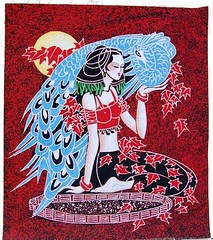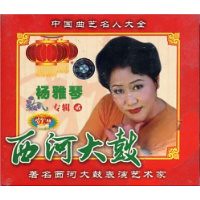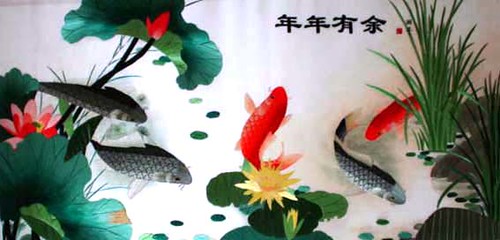| Home > Living in China > Art |
Batic: Pearl of Art
 |
Batik, one of the oldest handicrafts, has been appreciated as a part of ancient Chinese civilization since the foundation of dyeing and weaving technology in China. It is a traditional Chinese folk art which combines both painting and dyeing.
Batik, also known as laran or wax printing, is an artistic technique used by dipping a specially designed knife into melted wax and painting various patterns on pieces of white cloth. The wax stays on the cloth and often cracks after it hardens. The cloth is then dyed and the dyes seep into the un-waxed material as well as between the cracks. When the wax is boiled away, beautiful patterns are left on the cloth.
Indigo is the color chiefly used for the basic batik throughout Guizhou. An indigo paste is made from the harvested plants which have been soaked in a wooden barrel.
Where did batik come from?
The history of batik can be traced back to the Western Han Dynasty (206 BC-24 AD). There are batiks found in the Mawangdui tomb, which belonged to a noblewoman called Xing Zhui of the Western Han Dynasty (206 BC-AD 24), which was excavated in Changsha, capital of Central China’s Hunan Province, in 1972.
Nobody knows how the batik style was invented, but a folk tale about a “batik girl?tells explains one theory. The story relates that long, long ago, there was a girl living in a stone village called Anshun, now a city in Guizhou Province. She was fond of dyeing white cloth blue and purple. One day, while she was working, a bee happened to alight on her cloth. After she took away the bee, she found there was a white dot left on the cloth, which looked very pretty. Her finding led to the use of wax in dyeing.
Batik used to be popular both in Central and Southwest China but was somehow lost in Central China. It has however been handed down from generation to generation among the ethnic people in Guizhou and neighboring provinces, in the South-West of China. Today, you can still find traditional batik being made by the Miao, Bouyei and Gejia people.
Batik of Minorities
Batik involves long painstaking work but follows a rather simple process. First, bee-wax is melted in a bowl; then a special brass knife is used to pick up the liquid wax and make patterns with it on the cotton. The cloth is immersed completely in a jar of indigo liquid so that the unwaxed parts take on color. The dyed cloth is boiled to melt off the wax and leave clear patterns in white on a blue ground.
In the process of printing, the dye penetrates fine cracks naturally formed in the solidified wax, leaving hair-thin blue lines on the un-dyed white designs and enhancing the charm of the end product. And as the fine lines differ, no two pieces of cloth are identical even though they may beat the same pattern.
Their motifs carry meanings. For example, their finely drawn circular and double spiral designs represents the horns of the water buffalo, symbolizing their ancestor’s life and death. Their more traditional designs are geometric, where the most skilled wax resist reads as a fine blue line on a white ground. With the influence of the Han Chinese more figurative designs like flowers, birds and fish have been introduced over the centuries.
In the ethnic areas, batik is used extensively on many cloth articles, from dresses, skirts, kerchiefs, and belts to handkerchiefs, pillows, pillow slips and bedcovers. From tablecloths, curtains, tapestries to handbags, satchels and cushions.
Among the Miao nationality, a minority ethnic group in Southwest China, young girls are taught to make batik, to weave, and to embroider from an early age. Custom demands that they make their own garments, from wedding dresses to funeral shrouds.
Modern Art
Today, a large number of artists have used the traditional art of batik in innovative and modern works. They have introduced new themes and have included more cultural and social messages - adding issues and concepts from the modern era to the long line of batik storytelling.
Batik offers ample scope for artistic imagination in the making of patterns. Those commonly seen are floral, geometric and spiral designs, but folk painters may also follow their artistic inclinations and draw flowers, birds, beasts, insects or fish. The patterns in all cases are enchantingly simple with rich local flavor.
Batik cloth can be made into garments, scarves, bags, table-cloths, bedspreads, curtains, and other decorative items. With the development of tourism in China, batik articles are growing in popularity as attractive souvenirs of certain Chinese provinces.
Tips for owning Batik art
Batik cloth can be made into garments, scarves, bags, table-cloths, bedspreads, curtains, and other decorative items. However, because the raw material for batik is pure cotton cloth, care must be taken in maintenance to prevent moisture and erosion of the batik cloth in case of mildew.
Were it bought for use of collection (not for decoration), regular exposure to sun is required. Batik may be washed with water at any time, but do remember not to use detergent during the washing process or the color may fade. It is also advisable to wash them by hand to stop damage to the edges of the pice, which is often where their outstanding effects are found. Ironing is fine after washing. After buying the batik products, you may then begin to arrange mounting. At the same time, since batik is made from 100% pure cotton, it is the best choice for making clothes, quilt covers and bed-sheets. If used properly, batik can make your house or office unique and inviting.
Art
 more
moreChinese Traditional Art---- Xihe
Famous Star of Xihe Dagu---Yangyaqin Xihe

The Romance of butterfly lovers

Introduction to Suzhou Embroidery
Suzhou embroidery-one of China's four famous embrodiery styles, has a

Customs
 more
more



 print
print  email
email  Favorite
Favorite  Transtlate
Transtlate 
